Cruet Sets
Cruet Sets
Single casters for sugar or pepper were made from the 1680’s onwards however the earliest cruet frames are not found before 1700. These usually contained 3 castors and 2 glass bottles and could be passed around the table from guest to guest. This form is generally known as the “Warwick” cruet after the stand created by Anthony Nelme in 1715 for the Duke of Warwick. At this early date the two bottle oil and vinegar frame also existed although this form was more popular on the continent.
Later, as the 18th century progressed, the number of bottles could be as many as 8 or 10 which would have contained a variety of sauces of the period such as soy, ketchup, tarragon etc. The bottles may have also had little sauce labels to identify the contents.
History of the Cruet Frame
The turn of the 1700’s saw a dramatic change in the way that food and drinking beverages were served in this country. At that time, many of the medieval traditions to do with eating and drinking were being replaced by the fashion for dining “a la francaise”, a style which was swiftly gaining popularity and introduced many new dishes such as soups, stews and terrines. All the dishes for each course were placed simultaneously on the table – guests could help themselves and required less assistance from servants. This, plus the arrival of new drinking beverages tea, coffee and chocolate, created a demand for many exciting new types of silverware and the silversmiths’ shops were quick to make available the latest vessels and designs. Silver tableware had now become the main source of table decoration.
In order to accommodate large scale formal dining the fashionable tables of the aristocracy would have had a “surtout”, an elaborate table centrepiece fitted with tureens, dishes, cruet stands, maybe even candle branches, whereas the dining tables of the gentry and prosperous middle classes would have featured a multi-purpose condiment stand to hold the glass bottles for oil and vinegar and silver casters for sugar and spices.
-

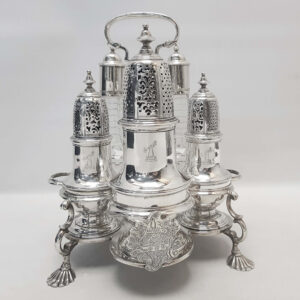
1738
Samuel Wood
10327 George II Silver Warwick Cruet
Sold
A handsome antique silver cruet set with a matching set of 3 silver casters and 2 silver and faceted crystal oil and vinegar bottles. The cinquefoil frame has 4 shell feet and a shaped decorative cartouche to the front with a hand engraved armorial. Each caster and bottle bears the same matching crest. Total weight of silver 1288 grams, 41.4 troy ounces. Caster height 17.75cm and 14cm. Bottle height 17cm. London 1738. Maker Samuel Wood, known for his silver casters.
-

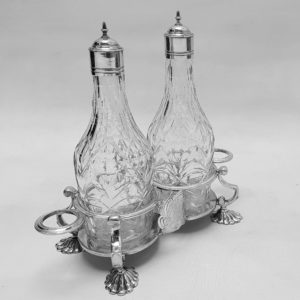
Circa 1750
10274 George II Antique Silver Oil and Vinegar Set
A good quality Irish antique silver condiment set with broad shell feet and a carrying handle. Very heavy weight and thick gauge silver. The silver frame has a handsome wheatsheaf and shell design cartouche containing an unusual hand engraved armorial of “dancing pigs below 2 axes”, possibly for one of the Irish Mac Sweeney lines The cut crystal bottles are very beautiful and have detachable silver tops which fit onto the side rings when the bottles are in use. Weight of stand and silver tops 477 grams, 15.3 troy oz. Total height 19.7cm. Stand width 21cm. Bottle height 17.3cm. Dublin circa 1750. Sterling silver. 18th century.
-

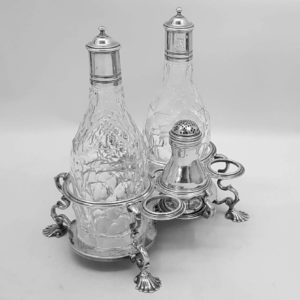
1751
Elizabeth Godfrey
9913 George II Silver Cruet Set
A rare early English silver cruet with two bottles for oil and vinegar and a small silver castor or pepperette. Excellent weight and large size. The heavy cut crystal bottles have multi-faceted cut decoration, typical of the period. The silver frame has an acanthus scroll carrying handle and side supports for the bottle tops and pepperette. The top of the frame has a hand engraved armorial which matches those on the bottle tops. Total weight of silver 955 grams, 30.7 troy ounces. Height 23.5cm (overall), 20.7cm (bottle), 9.5cm (pepper). Base measures 19.3 x 16.3cm. London 1751. Maker Elizabeth Godfrey, a highly respected Huguenot lady silversmith.
-

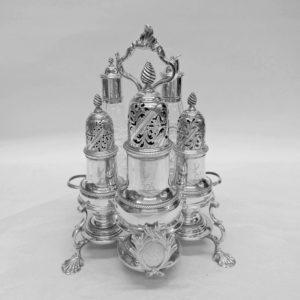
1761 - 1764
John Delmester
10390 George III Antique Silver Warwick Cruet
A handsome antique silver cruet set with a matching set of 3 silver casters and 2 silver topped and faceted crystal oil and vinegar bottles. The cinquefoil frame has 4 shell feet and a shaped decorative cartouche containing a hand engraved armorial. An unusual feature is that one small caster has been fitted with a plain inner sleeve; this is known as a “blind caster” which is the earliest form of mustard pot. Total weight of silver 1498 grams, 48.1 troy ounces. Caster height 19.5 and 16 cm, bottle height 18.3 cm, each with a matching hand engraved crest. Casters London 1764, frame London 1761. Maker John Delmester.
-

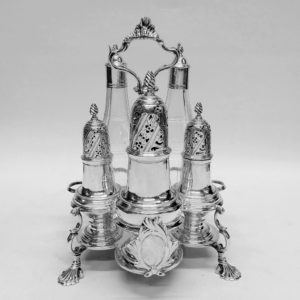
1762
John Delmester
9155 George III Antique Silver Warwick Cruet
Sold
A handsome antique sterling silver cruet set with a matching set of 3 silver casters and 2 silver topped and faceted crystal oil and vinegar bottles. The cinquefoil frame has 4 shell feet and a shaped decorative cartouche containing a hand engraved armorial. Total weight of silver 1214 grams, 39 troy ounces. Caster height 17 and 13.5 cms, bottle height 19 cms, each with a matching hand engraved crest. Casters and frame London 1762. Maker John Delmester.
-

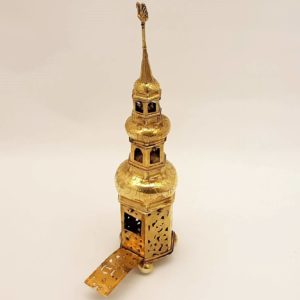
Circa 1890
9629 Antique German Silver Spice Tower
Sold
Of Jewish interest. A large continental silver spice box in the form of a medieval tower with a turret surmounted by a cockerel. All over gilded. The top 2 sections, each containing a bell, sit above the spice box which has pierced and engraved decoration. The box has a drop-down door with scroll catch. Weight 286 grams, 9.1 troy ounces. Height 32 cm. Continental silver marks. Possibly Hanau, Germany. Circa 1890.